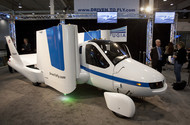Flying Auto Reviving Dreams of Chitty Chitty Bang Bang
 The Terrafugia Transition seats two and can take off and land from more than 5,000 public U.S. airfields. It can be driven on any road and runs on the same gasoline as high- performance cars. So far, the company said, 95 people have put down at least $10,000 to reserve one of the $279,000 planes. Depositors include pilots and the wealthy in search of the latest toy.
The Terrafugia Transition seats two and can take off and land from more than 5,000 public U.S. airfields. It can be driven on any road and runs on the same gasoline as high- performance cars. So far, the company said, 95 people have put down at least $10,000 to reserve one of the $279,000 planes. Depositors include pilots and the wealthy in search of the latest toy.The Transition will be on display to the public at the New York auto show, which finishes on Sunday April 15, with a special offer to reserve one for a $2,500 non-refundable deposit.
Dietrich says eventually selling 500 Transitions per year is an optimistic yet realistic goal.
Flying cars have long captured the imagination, including a movie and play based on “Chitty Chitty Bang Bang,” the children’s book by Ian Fleming.
One of the Transition’s biggest obstacles is that no predecessor has ever succeeded commercially and become an “everyman’s airplane,” said Dom Pisano, curator in the aeronautics division of the Smithsonian National Air & Space Museum.
“Practicality is one huge reason,” Pisano said. “The aerodynamics for automobiles are very different than for airplanes and we’ve ended up with halfway measures in both categories, and that’s a big part of the reason they’ve failed.”
The Transition, which will require a sport pilot’s license, isn’t for everyone. Woburn, Massachusetts-based Terrafugia said its target market includes hedge-fund managers and other wealthy Wall Street types. Also among the intended customers are frequent fliers taking short trips for work or pleasure who are frustrated by the cost and hassle of owning a one-dimensional vehicle.
The Terrafugia Transition is designated a light sport aircraft, and it won’t be certified by the Federal Aviation Administration. That means it will be restricted to visual flight rules. It can fly only in daylight and in clear skies.
The Transition couldn’t enter Class A or B airspace around major commercial airports unless equipped with devices that help air-traffic controllers monitor a plane’s location and the pilot would need a higher-level license with more flying experience to enter airspace around even medium-sized airports, said Bill Waldock, a professor of safety and crash investigation at Embry- Riddle Aeronautical University in Prescott, Arizona.
The prototype plane has flown 28 times, Dietrich said. Two production prototypes recently began testing, and production is scheduled to start later this year, he said.
With the wings up, the vehicle is about the size of Honda Motor Co.’s (7267) Odyssey minivan. It will fit in the garages of most homes, Dietrich said.
And, in fact, even with a flying car, miles per gallon does matter, so: Dietrich said the vehicle gets 35 miles (56 kilometers) per gallon on the road and 20 miles per gallon while flying at 100 miles an hour.
You can return to the main Market News page, or press the Back button on your browser.

